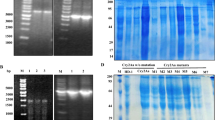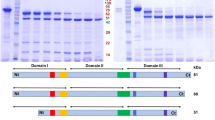Abstract
Bacillus thuringiensis produces several larvicidal crystalline inclusions during sporulation. An understanding of their mechanisms of action is commercially important. In this study, two toxins, Cry1Ab and Cry1Ac, were compared that showed 98% amino acid identity in domain I and II, but differed significantly in domain III. Using site-directed mutagenesis techniques, two conserved loop 2 Arg's (368RR369) of Cry1Ab and Cry1Ac toxins were replaced with Ala (368AR369, 368RA369, 368AA369), Glu (368EE369), Phe (368FF369), His (368HH369), and Lys (368KK369). The effect of these mutants on structural stability, larvicidal potency, receptor binding, and ionic permeability towards two important cotton pests, pink bollworm (Pectinophora gossypiella) and bollworm (Helicoverpa zea) were analyzed. All seven mutants of Cry1Ab, excluding 368AR369, produced a stable protoxin, whereas for Cry1Ac all seven mutants yielded stable protoxin. Results showed that all the stable mutants behaved similarly to the wild type on incubation with trypsin and gut extract of both insect larvae. The Cry1Ab mutants, 368AR369, 368AA369, 368FF369, and 368HH369, lost toxicity; 368EE369 had reduced toxicity; whereas the more conserved change 368KK369 retained the toxicity similar to the wild type towards P. gossypiella. Double mutants of Cry1Ac, 368AA369 and 368FF369, abolished the toxicity. Double mutant 368KK369 of Cry1Ac retained its toxicity against P. gossypiella, whereas single mutants 368AR369, 368RA369, and 368HH369 retained only reduced toxicity. All the mutants of Cry1Ab lost their toxicity against H. zea except 368KK369. In Cry1Ac single mutants, 368AR369 and 368RA369, reduction in the toxicity was observed. A double mutant of Cry1Ac, 368KK369, also retained reduced toxicity. All the other double mutants lost their toxicity. Voltage clamping experiments on H. zea midguts provided an additional evidence about the insecticidal property and inhibition of Isc across the transepithelial membrane of the insect midgut.
Similar content being viewed by others
Author information
Authors and Affiliations
Additional information
Received: 5 June 2000 / Accepted: 5 July 2000
Rights and permissions
About this article
Cite this article
Karim, S., Dean, D. Pesticidal and Receptor Binding Properties of Bacillus thuringiensis Cry1Ab and Cry1Ac δ-Endotoxin Mutants to Pectinophora gossypiella and Helicoverpa zea . Curr Microbiol 41, 430–440 (2000). https://doi.org/10.1007/s002840010163
Published:
Issue Date:
DOI: https://doi.org/10.1007/s002840010163




